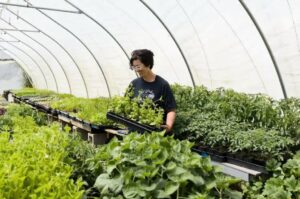‘Filling in the Gaps’ for Food Access: Women-Run Farms Rethink California Agriculture
At Radical Family Farms, Leslie Wiser recently planted bitter melons, what she refers to as “one of our most beloved crops”, a staple in many types of Asian cuisine that grows on a vine and is related to zucchini, squash and cucumber. It was a warm day on her three-acre farm, yet the cloud cover made it just right to be working on what Wiser says is her “dreamy but expensive” mixed-Asian vegetable farm that she started in 2018.
“Regenerative climate, smart farming takes a lot of time,” said Wiser, the child of Chinese-Taiwanese, German and Polish-Jewish immigrants who came into farming in her early 40s. She dreamed about growing vegetables that reflect her heritage and teach her children where their food comes from, and this is exactly what she’s doing.
Women like Wiser are increasingly the face of farming in California, and nationally as well. Experts say the growing presence of women in agriculture is having an impact on how the industry operates, especially in the face of generational challenges like pandemics and climate change, with research showing that women-led businesses are more likely to take a community-minded approach to how they operate and fill in gaps during crises. And as Congress prepares to debate its latest farm bill, many women are calling for it to provide more support for what the legislation calls “specialty crops”: locally produced fruits and vegetables, often grown by women, as opposed to heavily subsidized industrial staples such as wheat, corn and soybean.
Women in California today represent 37% of all the producers in the state, according to the most recent USDA Census of Agriculture – which only began tracking these numbers in 2017. And since 2009, women are clearly outpacing men in agricultural education.
Caitlin Joseph, Women for the Land program and policy manager at American Farmland Trust, said that 75% of the students who earned a bachelor’s degree in agriculture-related majors from 2019 to 2020 at the University of California, Davis, were women. This trend tracks with the rise in the number of women majoring in Stem (science, technology, engineering and mathematics) fields and establishing careers in physical and life sciences, which include agriculture.
Joseph said that young women might also be inspired by the “community supported agriculture model”, in which people farm together on land they co-own and do everything from grow food to raise children and feed their communities.
“We think there is strong evidence that women are a growing share of the people in California’s agriculture industry,” Joseph said. “We know that women have always been essential parts of the farming community in California. But their roles have often been overlooked in behind-the-scenes tasks that are undervalued as key pieces of [agricultural] operations’ success, such as bookkeeping, marketing or customer relationship building.”
Now they are more and more a part of the actual production. This trend in California mirrors a similar shift nationally. Between 2012 and 2017, the number of women-operated farms grew by 23% in the US.
In her dissertation about women farmers for Utah State University, published in 2019, Ennea Fairchild wrote: “Not only are women making up at least a third of those in most agricultural fields, but … their numbers are continuing to grow, with women increasingly becoming involved in all aspects of agriculture.”
